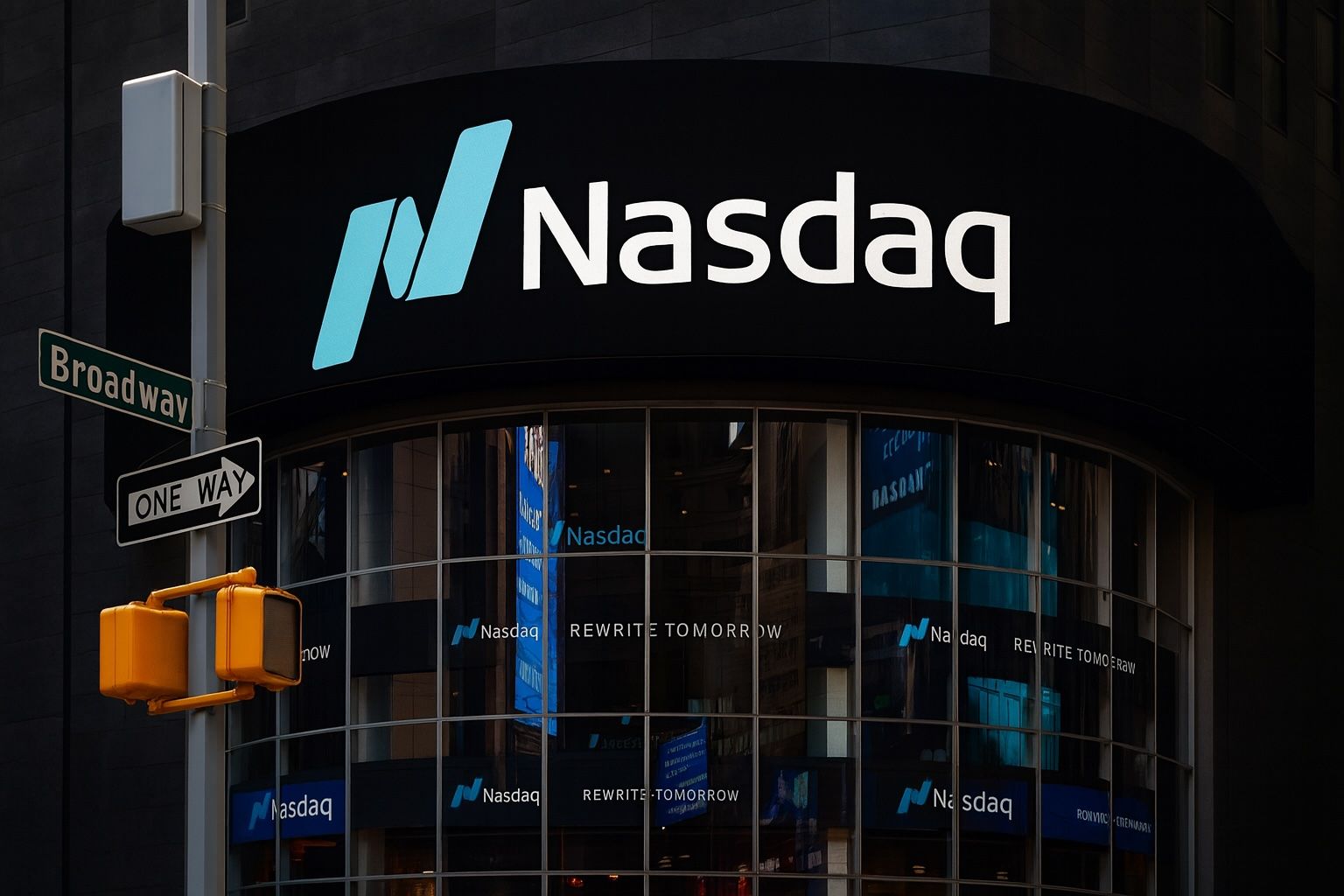- Fed poised for first rate cut of 2025: Investors widely expect the U.S. Federal Reserve to cut interest rates by 0.25% at this week’s Sept. 16–17 meeting, with futures implying a ~95% probability of a quarter-point cut [1]. President Trump has urged an even larger reduction, but Fed officials are likely to frame any move as a cautious “insurance” cut amid mixed economic signals [2] [3].
- Asian markets gain on Fed hopes: Asian stock futures signaled a positive open – Hong Kong and Sydney pointed higher – as Wall Street’s recent rally and expectations of Fed easing bolstered sentiment [4]. Tokyo was an outlier (reopening after a holiday), but overall optimism in Asia is underpinned by bets that a U.S. rate cut is already priced in [5].
- Wall Street near records, but in wait-and-see mode: U.S. equities surged to record levels last week amid anticipation of Fed rate cuts [6]. However, by Tuesday traders turned more cautious – the S&P 500 and Nasdaq pared gains and were nearly flat as many investors sat on the sidelines awaiting the Fed’s announcement [7] [8].
- European stocks pull back ahead of Fed: Major European indexes fell to one-week lows, with the STOXX 600 down ~1.1% on Tuesday as rate-sensitive bank and insurance shares slid over 2% [9]. Jitters over the Fed decision, alongside regional growth concerns, have tempered Europe’s earlier gains and put markets in a defensive mood.
- Inflation stable, dollar and gold react: U.S. inflation rose slightly in August (~2.9% year-over-year, core 3.1%), still above target but not surging [10]. Combined with a cooling labor market, this has “sealed the deal” for a Fed cut, according to market observers [11]. The dollar has weakened to multi-week lows as rate-cut bets rise [12], while gold prices have jumped to record highs in anticipation of easier monetary policy [13].
The world’s financial markets are fixated on the Federal Reserve’s upcoming rate decision, which is shaping up to be one of the most consequential of the year. Investors across Asia, Europe, and the Americas are bracing for the Fed’s policy announcement on Wednesday, widely expected to deliver the first U.S. rate cut of 2025 [14]. This anticipated shift in U.S. monetary policy comes amid a complex global economic backdrop – one marked by moderating inflation, signs of slowing growth, and pockets of geopolitical tension. With stock indices recently at or near record highs and bond yields retreating, markets have been positioning for a more accommodative Fed, even as they remain wary of any surprises. Below, we provide a comprehensive overview of the economic landscape and market sentiment around the world, and what might lie ahead depending on how the Fed’s decision unfolds.
Global Economic Landscape and the Fed’s Outsized Influence
Global central banks in focus: The Fed’s meeting leads a week of key central bank decisions worldwide, underscoring how U.S. policy is setting the tone for markets. In addition to the Fed, the Bank of Japan and Bank of England have policy meetings this week – though those banks are widely expected to hold rates steady [15]. The Fed’s actions carry extra weight because the U.S. dollar and Treasuries remain linchpins of global finance. In fact, the Fed’s rate call this week will help shape monetary policy trajectories for half of the world’s ten most-traded currencies [16], underlining how a shift in Washington reverberates from Frankfurt to Tokyo.
Economic signals: On the eve of the Fed decision, the global economic picture is mixed. In the U.S., inflation has been relatively muted – the latest consumer price index showed prices up about 2.9% over the past year [17], a modest uptick partly tied to tariff-related costs but generally far below the peaks seen in 2022. Core inflation (excluding food and energy) is running around 3.1% [18], above the Fed’s 2% goal but not accelerating dramatically. Crucially, the U.S. labor market is losing momentum, with hiring slowing and the unemployment rate edging up to its highest level since 2021 [19]. These “signs of labor-market weakening and no major inflation surprises have sealed the deal” in investors’ minds that the Fed will cut rates by a quarter point at this meeting [20]. Indeed, Fed officials themselves have hinted at openness to an “adjustment” in policy stance given the changing economic circumstances [21].
Fed under pressure: Adding to the backdrop is an unusual degree of political pressure on the Fed. President Donald Trump has been publicly urging the central bank to slash rates more aggressively, calling on Fed Chair Jerome Powell to enact a “bigger” cut than what Powell “had in mind” [22]. In recent days, Trump not only intensified his rate-cut calls on social media, but also moved to influence the Fed’s leadership – for example, pushing through a Fed Board nominee aligned with his views [23]. While the Fed is independent, this climate of political jawboning is highly conspicuous. Analysts note the White House’s sway has become part of the story, highlighting “the degree of political pressure now bearing down on the central bank” [24]. Markets will be watching how Powell navigates this dynamic in his post-meeting press conference. The Fed is expected to stress that its decisions are driven by economic data (with an eye on both jobs and inflation) – in Powell’s words, balancing the two halves of its dual mandate – rather than by external political influence [25].
Global growth and other central banks: Beyond U.S. shores, economic conditions are also evolving in ways that put central banks on diverging paths. In Europe, inflation has cooled from last year’s highs and growth remains soft, leading the European Central Bank to pause its long series of rate hikes (and some investors speculating about potential rate cuts in 2024). This week, the Bank of England is expected to hold its policy rate unchanged, especially after data showed the UK’s labor market and wage growth finally softening [26]. The euro zone’s second-largest economy, France, just saw its credit rating downgraded by Fitch due to rising debt [27], but the euro was largely unmoved by that news [28] – a sign that markets are more fixated on the Fed than on Europe’s own fiscal concerns right now. Over in Asia, the Bank of Japan is likewise set to stand pat on rates [29], as it assesses a delicate balance of moderate inflation and wage upticks against decades of deflationary pressure. In short, the Fed appears poised to be the only major central bank easing this week, which has significant implications for capital flows and currency values worldwide.
Asian Markets: Cautious Optimism Ahead of the Fed
Asian markets are greeting the Fed week with a tone of cautious optimism. After Wall Street notched fresh all-time highs in recent sessions, Asian equities have been poised for a mostly positive open in kind [30]. Equity index futures signaled gains in key markets like Hong Kong and Australia to start the week, reflecting confidence that a Fed rate cut is in the offing and largely priced in [31]. “Asian stocks are [thus] poised for a mainly positive open” as one market wrap put it [32], buoyed by the prospect of lower U.S. interest rates which tend to support emerging market assets and risk appetite globally.
In Japan, trading resumed after a Monday holiday with a bit of catch-up hesitation – Tokyo stocks were hinted to “slip” slightly on reopening [33]. But broadly, the region’s sentiment remains constructive. Investors in Asia have taken heart not only from the Fed outlook but also from some market-friendly developments closer to home. For instance, a surprise boost to tech shares came after filings revealed Tesla CEO Elon Musk had acquired nearly $1 billion of his company’s stock last week, helping Tesla’s price jump and erasing its year-to-date losses [34]. This U.S. tech rally spilled over internationally, lifting sentiment for tech and growth stocks in Asia too. Additionally, U.S.-China trade tensions showed tentative easing: officials from both nations, meeting in Madrid, reached a framework agreement to keep the TikTok app operating under U.S.-controlled ownership [35]. President Trump even said he plans to speak with China’s President Xi Jinping on Friday to cement the deal, fostering hopes of further extending the trade truce between the world’s two largest economies [36]. Such news provided an extra dose of optimism in Asian markets, especially in China and Hong Kong, where policy-sensitive tech shares had recently been volatile.
Indeed, China’s markets have seen a mix of signals. Earlier this month, Chinese equities had rallied sharply – so much that Beijing reportedly stepped in to cool a “red-hot” stock surge (particularly in tech) by warning against speculative excess [37]. That intervention caused a brief selloff in Chinese bourses [38]. Now, with the Fed meeting at hand, Chinese assets are finding support again. The offshore yuan, for example, climbed to its highest level of the year this week [39], buoyed by both Fed-driven dollar weakness and the positive trade-talk developments. Still, caution lingers: China’s regulators announced they are continuing an anti-monopoly probe into U.S. chipmaker Nvidia [40], a reminder of ongoing geopolitical risk in the tech sector. Overall, however, the region’s markets are navigating these cross-currents fairly well. MSCI’s Asia-Pacific equity index (ex-Japan) is near multi-year highs, and Asian shares as a whole have logged solid gains in recent weeks, riding on the coattails of Wall Street’s strength.
Market commentators describe the mood as one of “cautious optimism”. Investors are optimistic that a U.S. rate cut will extend the global economic cycle and support asset prices, but they remain cautious until it’s confirmed. As Chris Larkin of E*Trade noted, the key question now isn’t whether the Fed will cut – that seems a given – but “how aggressively the Fed will act” going forward [41]. Asian traders know that the first cut may be just the start of a new rate trajectory. The Fed’s signals about future easing (or lack thereof) will be crucial for risk assets worldwide, including those in Asia’s emerging markets. For now, Asia is tentatively cheering the prospect of Fed stimulus, while keeping an eye on local risks like China’s policy moves and regional growth trends.
U.S. Markets: Rally Meets Reality Check
On Wall Street, the investor mood has swung from euphoria to cautious anticipation as the Fed decision draws near. Last week, U.S. stocks staged a remarkable rally: all three major indices – the S&P 500, Dow Jones Industrial Average and Nasdaq – hit record closing highs by the end of the week [42]. This “everything rally” was fueled by hopes that easier Fed policy is imminent. Weaker-than-expected U.S. jobs data earlier in the month had bolstered the case for rate cuts, and traders enthusiastically priced in not just a one-off cut, but potentially a series of reductions over coming months [43]. Big Technology stocks led the charge: for example, Alphabet (Google’s parent) saw its market capitalization surge past $3 trillion for the first time as its stock set a record high [44]. The tech-heavy Nasdaq is up roughly 16% year-to-date [45], outpacing broader indexes, thanks in large part to these mega-cap “Magnificent Seven” tech companies that have powered much of 2025’s gains [46].
However, as trading began this week, U.S. markets hit the pause button. By Tuesday, the S&P 500 and Nasdaq were only slightly changed on the day, and the Dow ticked down, in what one Reuters report described as indexes “slip[ping] as investors turned cautious ahead of [the] Fed rate decision” [47]. In other words, the rally “hit a wall” as traders refrained from making big new bets before hearing from the Fed. Volume has lightened and volatility has ebbed – a sign of the market in wait-and-see mode. “What we see is just a broad-based lack of conviction, with traders relatively happy to sit on the sidelines and wait” for the Fed’s outcome, explained Michael Brown, a market analyst at broker Pepperstone [48]. Indeed, many market participants are squaring up positions rather than initiating new ones, opting for caution until the policy picture becomes clearer [49].
Some fresh data did arrive on Tuesday, but it did little to change the dominant narrative. Notably, U.S. retail sales for August came in stronger than expected (rising +0.6% vs +0.2% forecast) [50], suggesting consumer demand remains resilient. Normally, a strong retail report might raise questions about the need for rate cuts (stronger spending can signal inflationary pressure). However, this time the robust retail figures “did little to change rate cut expectations” on Wall Street [51]. Investors largely shrugged off the data, reasoning that one month of solid sales won’t dissuade the Fed from an easing path given the bigger picture of cooling employment and tame inflation. As one investment strategist, Ross Mayfield of Baird, noted, if anything these upside economic surprises “reaffirm the hawks” at the Fed and could prompt Powell to sound a bit more cautious in delivering the cut [52]. In other words, good news on the economy could translate into a slightly less dovish tone, but not a full change in course.
Meanwhile, specific stock stories are adding both ups and downs to the mix. The earlier-mentioned Musk purchase of Tesla shares gave a boost to sentiment on Monday (Tesla stock jumped ~3.6% on the news) [53]. Also on Monday, Oracle shares soared on reports of the TikTok deal framework, as Oracle would be a key cloud provider in that arrangement [54]. However, other pockets of the market have seen pullbacks; for example, some healthcare stocks lagged, weighing on the Dow Tuesday [55]. Overall, the U.S. market is holding near its highs, but with a clear “hold your breath” attitude until the Fed’s decision is out. The S&P 500 is less than 0.5% below its record, and the broad market has advanced about 12% year-to-date [56], which sets a high baseline of optimism. Whether that optimism is justified will depend greatly on how accommodative the Fed sounds going forward.
In summary, Wall Street’s posture heading into the Fed announcement can be characterized as optimistic but anxious. Stocks have rallied on the rumor (of rate cuts), and now investors await the news. The prevailing expectation – a 0.25% cut – is so well telegraphed that any deviation or unexpected tone from the Fed could jolt the markets. If Powell emphasizes that the cut is just an “insurance” measure and maintains a balanced stance, stocks could hold their gains. But any hint that the Fed is less willing to ease policy further (or conversely, a hint of deeper economic worries prompting bigger cuts) could trigger swift re-pricing. Thus, U.S. traders are glued to not just the rate decision itself, but also the Fed’s forecasts and Powell’s press conference to gauge what comes next.
European Markets: Jitters and Rate Sensitivity
In Europe, equities have taken a more cautious turn in the lead-up to the Fed meeting, after initially benefiting from the global rally. On Tuesday, the pan-European STOXX 600 index fell over 1%, hitting its lowest level in a week [57]. The decline was led by rate-sensitive sectors: bank stocks and insurance companies – which typically see profits squeezed by lower interest rates – tumbled around 2% on the day [58]. Major national indices mirrored the slump, with Germany’s DAX, France’s CAC 40 and Britain’s FTSE 100 all registering steep losses alongside the STOXX 600 drop [59].
This pullback reflects a few factors. First, European investors are “turning cautious in the run-up to the Fed’s verdict” [60], just as their U.S. and Asian counterparts are. The prospect of the Fed easing has somewhat mixed implications for Europe: on one hand, a Fed rate cut can support global growth and weaken the dollar (which can be positive for European exporters); on the other hand, falling U.S. yields put downward pressure on European yields too, which dents bank margins. The sharp drop in European bank and insurance shares suggests the market is pricing in lower interest rates globally, and thus lower future profits for lenders. It’s a reminder that not all sectors cheer a Fed cut – financial firms often prefer higher rates.
Secondly, Europe has its own set of worries. Economic growth in the eurozone has been anemic, and there are persistent concerns about industrial output in powerhouse Germany and fiscal challenges in countries like Italy and France. A recent example: France’s credit rating downgrade by Fitch (from AA to AA- late last week) highlighted concern over its rising public debt [61]. While the euro’s exchange rate barely budged on that news [62], it contributed to a general sense of caution in European markets. Additionally, the UK is facing slowing job growth and easing wage pressures [63], which, while good for inflation, indicate a cooling economy. The European Central Bank (ECB), after raising rates steadily, opted to hold rates unchanged at its last meeting, and investors are now debating if the ECB’s next move might even be a cut sometime in 2024. That means Europe could be at an inflection point too, and European traders are looking to the Fed for cues on the direction of global monetary policy.
It’s worth noting that European markets had participated in the global upswing earlier. As of late last week, the FTSEurofirst 300 index of top European shares was up, and on September 4 it rose about 0.6% in one session amid rate-cut optimism [64]. But that optimism has been tempered as reality sets in that much of the good news is already priced in. The question in Europe is similar to the U.S.: will the Fed meet, exceed, or disappoint expectations? A smooth, dovish Fed message could rekindle the rally in Europe, especially benefiting export-oriented and technology shares. Conversely, any sense that the Fed might hesitate (or that the U.S. economy might be weaker than thought) could add to Europe’s woes, given its fragility.
In the UK, attention is also on the Bank of England (BoE), which meets a day after the Fed. UK stocks have been choppy as well; the internationally exposed FTSE 100 index often moves inversely to the pound. With sterling having climbed to its strongest level since early July (around $1.36) ahead of the Fed [65], UK exporters have felt a bit of a pinch, contributing to equity softness. The BoE is expected to hold its rate, especially since British inflation has been gradually coming down from double-digit peaks and the latest data showed a slight loosening in the tight labor market [66]. European bond markets, meanwhile, have seen yields slip from recent highs – for example, Germany’s 30-year yield eased to ~3.3%, after concerns about deficits had pushed yields up earlier [67]. This mirrors moves in U.S. Treasuries and indicates that global bond investors are starting to price in a coming era of easier monetary policy.
In summary, European markets are in a holding pattern with a downside bias before the Fed. The continent’s stock investors are caught between hope (that cheaper money will boost economic activity) and fear (that any further economic weakness or policy error could tip Europe towards stagnation). The result has been a modest pullback and a sector rotation: defensive, rate-insensitive sectors (like utilities or healthcare) have held up better, while banks and cyclical stocks lag. Europe will take its cues directly from the Fed outcome: a clear signal of U.S. easing could give European equities a relief rally, whereas any disappointment might deepen the slide, at least in the short term.
Inflation Trends, Currency Movements, and Geopolitical Risks
A key factor underlying the Fed’s deliberations – and thus market sentiment – is the trajectory of inflation. After a brutal inflation surge in 2022, price increases have moderated significantly on both sides of the Atlantic. In the U.S., as noted, CPI inflation is hovering just under 3% [68]. There were no “major inflation surprises” in recent months [69], meaning inflation has neither re-accelerated nor fallen precipitously beyond expectations. This stability has given the Fed cover to pivot toward easing in order to address the more pressing issue of a slowing job market. However, inflation isn’t completely vanquished: core inflation at 3%+ remains above target, and consumer inflation expectations have ticked up slightly (Americans’ median 5-year inflation expectation rose to 3.9% from 3.5%, per a recent survey) [70]. Fed officials must be mindful that cutting rates too aggressively could risk reigniting price pressures – a point likely to be emphasized if Powell strikes a balanced tone.
In Europe, inflation has fallen from double digits a year ago to nearer 5% in the eurozone (and 6.7% in the UK) – still above comfort levels, but clearly on a downward trend. The ECB has said euro-area inflation should continue to decline, which is why it paused hikes. Yet, factors like oil prices (which have risen lately) and wage settlements will determine how fast inflation returns to 2%. The Bank of England, for example, must weigh an unexpected uptick in UK wages earlier this summer against more recent signs of cooling. All told, global central bankers are trying to engineer a soft landing: bringing inflation down without tanking growth. The Fed’s possible rate cut is seen as part of that delicate dance – providing a bit of stimulus to ensure that disinflation doesn’t morph into recession.
On the currency front, expectations of diverging monetary policies have already driven notable moves. The U.S. dollar has been weakening in the days before the Fed meeting. In fact, the dollar index (DXY) slipped to a one-week low on Monday [71] and by Tuesday the dollar sank to a two-month low against major currencies [72]. This dollar softness is directly tied to the prospect of rate cuts: lower U.S. interest rates make the dollar less attractive to yield-seeking investors, who had flocked to the greenback during the Fed’s hiking cycle. Euro and yen have both gained ground versus the dollar – the euro was up about 0.3% around $1.177, a multiweek high [73], and the Japanese yen strengthened to ~147.3 per dollar from recent 148+ levels [74]. These moves, while modest, show a market positioning for a Fed that is moving toward easing while the ECB and BoJ stand pat (narrowing the interest rate differential).
Importantly, China’s yuan has also strengthened against the U.S. dollar. The offshore yuan hit its highest value of 2025 this week [75]. Part of this is the dollar’s broad pullback, but part is also Chinese authorities’ efforts and the improved tone in U.S.-China trade discussions. A stronger yuan is welcome news in Beijing, which had seen its currency slide earlier in the year amid economic woes. Similarly, other emerging market currencies – from Asian tigers to commodity currencies like the Australian dollar – have been steadier or climbing in anticipation of a more dovish Fed. In fact, investors have been cutting their dollar exposure at a record pace recently, according to a Deutsche Bank analysis, rotating into other currencies as the dollar’s bullish run fades.
Gold, meanwhile, has been a major beneficiary of the current environment. The precious metal tends to thrive when interest rate expectations fall (since gold yields no interest, lower competing yields make it more attractive) and when the dollar weakens (gold is priced in dollars). True to form, gold prices have surged to new record highs in recent days [76]. On Tuesday, gold was trading around levels not seen before, reflecting both a hedge against economic uncertainty and enthusiasm that looser monetary policy globally will burnish gold’s appeal. Safe-haven demand hasn’t disappeared either – lingering worries (from geopolitical risks to high government debt levels) give investors reasons to hold gold as an insurance asset.
Turning to geopolitical and policy risks, markets are not entirely in a Fed bubble; they are also tracking other developments that could sway sentiment. The U.S.-China relationship remains a central focus. The progress on the TikTok deal and continued tariff negotiations are positive signs [77]. Beijing’s recent move against Nvidia, however, shows the tech rivalry persists [78]. Any escalation in trade or tech disputes could quickly sour risk sentiment, Fed cut or not. Elsewhere, energy markets pose a risk: oil prices have been volatile, and any spike (perhaps due to geopolitical tensions in the Middle East or supply decisions by OPEC+) could complicate the inflation outlook again. In the U.S., there’s also the looming issue of a potential government shutdown (as budget deadlines approach in the fall) and the upcoming presidential election year – political drama that could inject volatility into markets.
One unusual risk factor this time is the question of Fed independence and credibility. With President Trump openly discussing replacing Fed Chair Powell when his term ends next year [79] and even litigation briefly affecting one Fed Governor’s participation [80], there’s a heightened focus on how the Fed navigates political interference. So far, markets seem to trust that the Fed will do what it thinks is right for the economy – indeed, the Fed not cutting this week (defying market expectations) would likely be interpreted as the Fed asserting its independence but would shock markets. Conversely, if the Fed delivered an unexpectedly large cut (50 bps) that aligned with Trump’s wishes, some might view it as caving to pressure – but markets would probably still rally on the stimulus in the short run. It’s a delicate situation, and Powell’s messaging will be closely parsed for any hints of politicization (though none is expected in his careful language).
Summing up the broader context: inflation trends are favorable enough to permit easing, currencies are adjusting to a world where the U.S. no longer leads on high rates, and geopolitical undercurrents remain a wildcard that could either improve (trade peace) or worsen (new conflicts or trade wars). Investors have one eye on these factors even as the other eye stays firmly on the Fed this week.
Potential Market Outcomes: Fed Scenarios – Pause vs. Cut (or More)
Given that a quarter-point Fed rate cut is fully expected by most observers [81], the market’s reaction will hinge on two main things: (1) whether the Fed meets or deviates from that expectation in its rate decision, and (2) what signals the Fed sends about future policy (the pace and extent of further rate moves). We can outline a few potential scenarios and their likely market outcomes:
- Baseline scenario – 0.25% rate cut (as expected): This is what markets have already priced in [82]. If the Fed delivers a 25 basis point cut and communicates it as a moderate, “one-and-evaluate” move, the immediate market reaction could actually be muted. Since investors largely anticipate this outcome, there may not be a huge rally on the news alone. However, attention will swiftly turn to the tone of the Fed’s statement and the “dot plot” forecasts of future rates [83]. If Powell emphasizes that the Fed is committed to supporting the economy and hints that further easing is on the table if needed, markets could interpret that dovishly and extend gains. Stocks would likely grind higher (especially rate-sensitive sectors like technology and real estate), bond yields would edge down further, and the dollar might continue to soften. One key phrase to listen for is if Powell notes inflation is “well anchored” and the labor market is “cooling” – language that Fawad Razaqzada of City Index says would be “music to the ears of dollar bears” [84] as it implies the Fed is comfortable easing. Under this baseline, expect a continued “risk-on” environment: equities supported, gold strong, and possibly a gentle rally in emerging markets due to the friendlier liquidity conditions.
- More hawkish scenario – Fed pauses (no cut) or downplays future cuts: While unlikely (only about a 4–5% market-implied chance), it’s worth considering. If the Fed were to hold rates steady and not cut at all, it would surprise virtually everyone. The reaction would likely be sharp: stock markets would probably sell off swiftly as investors recalibrate to a Fed that is not as dovish as thought. Bond yields would jump (since no cut means higher-for-longer rates), thus bond prices would fall. The U.S. dollar would likely surge as traders unwind bets on its decline [85]. Essentially, this would be a shock tightening of financial conditions relative to expectations. The Fed might justify a pause by citing still-elevated core inflation or a desire to gather more data. They might also project fewer future cuts in their dot plot. If Powell sounds very concerned about inflation creeping back up, markets could fear the Fed will be less accommodative going forward. Equities globally would react negatively – given how much of the recent rally hinged on Fed hopes, a hawkish surprise could send the S&P 500 and global indices down several percentage points in the near term. One strategist’s comment encapsulates this risk: any “resilient economic data” could stiffen the Fed’s hawkish resolve and give Powell cover to be “more hawkish than the market is hoping for”, as Baird’s Ross Mayfield put it [86]. That would be the nightmare scenario for bulls. However, because the economic data of late doesn’t obviously call for hawkishness, this scenario has a low probability.
- More dovish scenario – larger cut (e.g. 0.50%) or strong easing signals: There’s a small chance (about 5% implied odds) that the Fed could go bigger and cut rates by 50 basis points [87]. This would be a genuine surprise on the dovish side. If such a half-point cut were announced, initially markets would likely celebrate: stock indices could spike higher, perhaps viewing it as the Fed decisively supporting growth. Bonds would rally hard (yields plunging on the bigger-than-expected rate relief), and the dollar could drop significantly further. Gold and other commodities might jump as well due to the dollar weakness and reflation hopes. However, a caveat: a larger cut might also raise an eyebrow – why is the Fed cutting so much? Do they see something ominous in the economy? So the sustainability of a rally would depend on Powell’s explanation. If he portrays it as simply getting ahead of the curve (or acceding in part to political pressure), and if the Fed’s new economic projections show only mild concern (e.g., slightly lower growth forecasts, still above-recession), then markets may run with the bullish interpretation. On the other hand, if a big cut comes with sharply downgraded forecasts, investors might grow fearful that a downturn is coming, potentially tempering the risk-on reaction. Overall though, a dovish surprise likely skews positive for stocks in the short run – as one trader quipped, an “everything rally” tends to greet the prospect of easier money [88].
- Forward guidance – the “dot plot” and Powell’s tone: Regardless of the size of the cut, what the Fed signals about the future is crucial. The Fed will release updated quarterly projections for growth, inflation, and the path of interest rates (the famous dot plot). In June, Fed officials were roughly split on how much more easing might be needed in 2025, with a slim majority penciling in two quarter-point cuts next year [89]. Markets will be keen to see if that outlook changes – do they hint at more cuts or fewer? Powell’s press conference will likely hammer home that any further moves are “data-dependent.” Analysts like Razaqzada suggest focusing on whether Powell uses phrases indicating comfort with inflation and the labor market, versus a “wait and see” stance [90]. A cautious Fed that hints at a pause after this cut (a one-and-done) could actually disappoint markets, possibly causing the current rally to stall or reverse [91]. Conversely, if Powell emphasizes downside risks and the need to ensure the expansion continues, it could be taken as a green light that the Fed is open to cutting again in subsequent meetings. Nomura’s economists, for example, expect the Fed to frame this as an “insurance” cut with a gradual easing path ahead [92], which would be a relatively market-friendly message (not too hawkish, not ultra-dovish). Essentially, the more the Fed commits to supporting growth (without sounding alarmed about inflation), the more risk assets are likely to benefit.
In all scenarios, it’s clear that the Fed’s credibility and communication skills will be tested. They must balance acknowledging improvements on the inflation front with caution about economic headwinds, all while preserving an image of independence. For market participants, the range of potential outcomes means we could see heightened volatility around the Fed announcement. Many traders have positioned lightly exactly for this reason – to be able to react once clarity emerges.
Bottom line: The prevailing market bet is that the Fed will deliver a modest cut and a mostly reassuring message, extending the global market rally. Yet, after a run-up of “buy the rumor,” there’s always the risk of “sell the news” if every dovish detail isn’t perfectly in line. Investors should be prepared for quick swings, but also keep focus on the bigger picture: even with a cut, interest rates will remain relatively high historically (likely in the 5.00% range for U.S. Fed Funds) and the fight against inflation isn’t necessarily over. The Fed’s decision could set the tone for the rest of 2025 – a year that might mark the transition from tightening to easing. As such, the stakes are high, and the world is watching.
Current Related News Highlights
To put this week’s market mood in context, here are some recent news headlines and brief summaries that capture the state of play:
- “Wall St indexes slip as investors turn cautious ahead of Fed rate decision” – Reuters, Sept 16, 2025: U.S. stocks gave up early gains and ended slightly lower on Tuesday as traders stayed cautious before the Fed announcement. The Dow fell 0.27%, while the S&P 500 and Nasdaq were nearly flat (-0.09% and -0.04% respectively) [93]. Despite strong August retail sales data, markets remained convinced a rate cut is coming and are now focused on what signals the Fed will send about future policy [94] [95].
- “STOXX 600 hits one-week low as banks, insurers slide ahead of Fed decision” – Reuters, Sept 16, 2025: European shares closed down over 1% on Tuesday, led by declines in financial stocks. Europe’s bank index fell about 2.1% as investors braced for the Fed’s policy update and its ripple effects on global interest rates [96]. Concerns that lower U.S. rates could squeeze bank profits contributed to the selloff, and some weak corporate news (like a profit warning in the recruitment sector) added pressure. Overall, the European market tone turned defensive before the Fed [97].
- “Dollar slips as traders await Fed interest rate decision” – Reuters, Sept 15, 2025: The U.S. dollar weakened to a one-week low against other major currencies as financial markets positioned for the Fed to resume cutting interest rates at this meeting [98]. President Trump’s fresh calls for a big rate cut underscored the unusual backdrop [99]. Currency analysts noted a “broad-based lack of conviction” in markets as traders preferred to wait for the Fed outcome, with the general view that the Fed will deliver a 0.25% cut and possibly signal more to come [100]. The dollar’s pullback boosted the euro (~$1.177) and yen (~¥147.3) [101], and gold prices ticked higher as well in advance of the meeting.
- “Morning Bid: Dollar takes Fed heat” – Reuters (Mike Dolan column), Sept 16, 2025: A global markets commentary noted an “everything rally” to start Fed week: stocks at record highs, bond yields down, and the dollar at a two-month low, all reflecting hopes of Fed easing [102]. It highlighted that gold hit a new record high and China’s yuan strengthened to yearly highs on optimism from U.S.-China trade talks in Madrid [103]. However, it also pointed out rising political pressure on the Fed – including Trump’s public push for cuts and moves to influence the Fed Board – creating an unusual backdrop for the meeting [104]. The piece set the stage for the Fed’s decision as a pivotal moment for the “2025 melt-up” in markets.
- “Asian Futures Show Cautious Optimism Ahead of Fed: Markets Wrap” – Bloomberg (via SharesBazaar), Sept 15, 2025: This markets summary reported that Asian stocks were set for a mostly positive open on Monday/Tuesday thanks to Wall Street’s advance and expectations of a Fed rate cut [105]. Hong Kong and Australian equity futures were up, while Japan’s Nikkei was seen dipping slightly after a holiday [106]. It noted that bets on Fed easing had lifted a broad Asian index above a key level (with one index topping 6,600 points) and that U.S. equity futures were steady near record highs [107]. The article also mentioned Elon Musk’s $1B purchase of Tesla stock erased Tesla’s 2025 losses, and news of a framework TikTok deal plus a planned Trump–Xi call further aided sentiment [108]. In short, Asia was optimistic but “cautious” – expecting the Fed to deliver stimulus while being mindful of potential surprises.
Each of these headlines underscores the central theme: markets globally are in a holding pattern, hopeful but cautious, as they await the Fed’s next move. From stocks and bonds to currencies and commodities, virtually every asset class has been touched by the anticipation of a U.S. rate cut. By Wednesday evening, we will know whether the Fed meets those expectations and how the narrative will continue into the final stretch of 2025. Will the current market optimism be validated with a smooth policy pivot, or will there be new twists in the tale? The world is watching the Fed – and preparing to react in real time.
Sources: Bloomberg, Reuters, Guardian, CBS News, and other market reports [109] [110] [111] [112] [113] [114].
References
1. www.reuters.com, 2. www.reuters.com, 3. www.reuters.com, 4. www.sharesbazaar.com, 5. www.sharesbazaar.com, 6. www.reuters.com, 7. www.reuters.com, 8. www.reuters.com, 9. www.reuters.com, 10. www.theguardian.com, 11. www.sharesbazaar.com, 12. www.reuters.com, 13. www.reuters.com, 14. www.reuters.com, 15. www.reuters.com, 16. www.sharesbazaar.com, 17. www.theguardian.com, 18. www.theguardian.com, 19. www.theguardian.com, 20. www.sharesbazaar.com, 21. www.theguardian.com, 22. www.reuters.com, 23. www.reuters.com, 24. www.reuters.com, 25. www.sharesbazaar.com, 26. www.reuters.com, 27. www.reuters.com, 28. www.reuters.com, 29. www.reuters.com, 30. www.sharesbazaar.com, 31. www.sharesbazaar.com, 32. www.sharesbazaar.com, 33. www.sharesbazaar.com, 34. www.reuters.com, 35. www.reuters.com, 36. www.reuters.com, 37. www.reuters.com, 38. www.reuters.com, 39. www.reuters.com, 40. www.reuters.com, 41. www.sharesbazaar.com, 42. www.reuters.com, 43. www.reuters.com, 44. www.reuters.com, 45. www.reuters.com, 46. www.reuters.com, 47. www.reuters.com, 48. www.reuters.com, 49. www.reuters.com, 50. www.reuters.com, 51. www.reuters.com, 52. www.reuters.com, 53. www.reuters.com, 54. www.reuters.com, 55. www.reuters.com, 56. www.reuters.com, 57. www.reuters.com, 58. www.reuters.com, 59. www.reuters.com, 60. www.reuters.com, 61. www.reuters.com, 62. www.reuters.com, 63. www.reuters.com, 64. www.reuters.com, 65. www.reuters.com, 66. www.reuters.com, 67. www.reuters.com, 68. www.theguardian.com, 69. www.sharesbazaar.com, 70. www.reuters.com, 71. www.reuters.com, 72. www.reuters.com, 73. www.reuters.com, 74. www.reuters.com, 75. www.reuters.com, 76. www.reuters.com, 77. www.reuters.com, 78. www.reuters.com, 79. www.reuters.com, 80. www.reuters.com, 81. www.reuters.com, 82. www.reuters.com, 83. www.sharesbazaar.com, 84. www.sharesbazaar.com, 85. www.reuters.com, 86. www.reuters.com, 87. www.reuters.com, 88. www.reuters.com, 89. www.sharesbazaar.com, 90. www.sharesbazaar.com, 91. www.sharesbazaar.com, 92. www.reuters.com, 93. www.reuters.com, 94. www.reuters.com, 95. www.reuters.com, 96. www.reuters.com, 97. www.reuters.com, 98. www.reuters.com, 99. www.reuters.com, 100. www.reuters.com, 101. www.reuters.com, 102. www.reuters.com, 103. www.reuters.com, 104. www.reuters.com, 105. www.sharesbazaar.com, 106. www.sharesbazaar.com, 107. www.sharesbazaar.com, 108. www.sharesbazaar.com, 109. www.sharesbazaar.com, 110. www.reuters.com, 111. www.reuters.com, 112. www.reuters.com, 113. www.theguardian.com, 114. www.reuters.com










